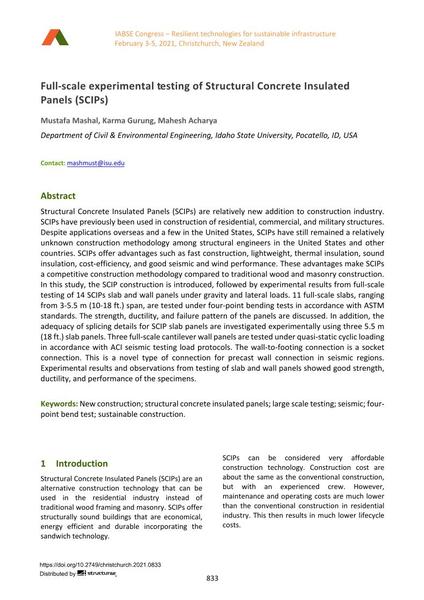Full-scale experimental testing of Structural Concrete Insulated Panels (SCIPs)

|
|
|||||||||||
Bibliographic Details
| Author(s): |
Mustafa Mashal
(Department of Civil & Environmental Engineering, Idaho State University, Pocatello, ID, USA)
Karma Gurung (Department of Civil & Environmental Engineering, Idaho State University, Pocatello, ID, USA) Mahesh Acharya (Department of Civil & Environmental Engineering, Idaho State University, Pocatello, ID, USA) |
||||
|---|---|---|---|---|---|
| Medium: | conference paper | ||||
| Language(s): | English | ||||
| Conference: | IABSE Congress: Resilient technologies for sustainable infrastructure, Christchurch, New Zealand, 3-5 February 2021 | ||||
| Published in: | IABSE Congress Christchurch 2020 | ||||
|
|||||
| Page(s): | 833-840 | ||||
| Total no. of pages: | 8 | ||||
| DOI: | 10.2749/christchurch.2021.0833 | ||||
| Abstract: |
Structural Concrete Insulated Panels (SCIPs) are relatively new addition to construction industry. SCIPs have previously been used in construction of residential, commercial, and military structures. Despite applications overseas and a few in the United States, SCIPs have still remained a relatively unknown construction methodology among structural engineers in the United States and other countries. SCIPs offer advantages such as fast construction, lightweight, thermal insulation, sound insulation, cost-efficiency, and good seismic and wind performance. These advantages make SCIPs a competitive construction methodology compared to traditional wood and masonry construction. In this study, the SCIP construction is introduced, followed by experimental results from full-scale testing of 14 SCIPs slab and wall panels under gravity and lateral loads. 11 full-scale slabs, ranging from 3-5.5 m (10-18 ft.) span, are tested under four-point bending tests in accordance with ASTM standards. The strength, ductility, and failure pattern of the panels are discussed. In addition, the adequacy of splicing details for SCIP slab panels are investigated experimentally using three 5.5 m (18 ft.) slab panels. Three full-scale cantilever wall panels are tested under quasi-static cyclic loading in accordance with ACI seismic testing load protocols. The wall-to-footing connection is a socket connection. This is a novel type of connection for precast wall connection in seismic regions. Experimental results and observations from testing of slab and wall panels showed good strength, ductility, and performance of the specimens. |
||||
| Keywords: |
sustainable construction new construction seismic structural concrete insulated panels large-scale testing four- point bend test
|
||||
